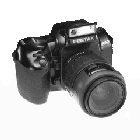
 One cold November morning my husband hooked a big steelhead from the banks of the Clearwater River. It was before sunup, and I wasn't sure my photos would turn out. I was tormented as I watched him release the beautiful heavy-bodied fish - especially since we had an article assignment on steelhead and badly needed the photos!
One cold November morning my husband hooked a big steelhead from the banks of the Clearwater River. It was before sunup, and I wasn't sure my photos would turn out. I was tormented as I watched him release the beautiful heavy-bodied fish - especially since we had an article assignment on steelhead and badly needed the photos!With camera still around my neck, I walked downriver and stepped out on a rock to cast - and slipped and fell into the icy water. It was deeper than I expected. I tried to hold up the camera, but it was easily forgotten as I struggled to right myself and climb out in heavy boots and soaked clothing.
I became aware of Lewis running toward me to help. "How sweet," I thought. Then I realized he was yelling, "GET THE CAMERA OUTA THE WATER!" I jerked the camera up higher and almost drowned laughing.
I quickly jogged and slogged for the camper while rewinding our precious steelhead exposures. Dripping profusely, I turned on the stove burners, took apart the camera, and began drying it out. Since it was never completely submerged, I thought I could save both it and the film.
Except for water spots on a few exposures, the film turned out OK. I learned later that wet film can be saved easily by quickly submerging the entire cassette in water. It can then be mailed or delivered in its plastic container, also filled with water, to the processors with an explanatory note.
Delicate camera electronics don't stand up well to being water-logged, however. I managed to rescue the lens, but the camera itself was a goner. (Experience has taught me that if even a little salt water gets on the film or in the camera, it's generally deadly to both.) Lesson learned. NEVER do I casually wear a camera around my neck on shore, in a boat, or while wading Idaho rivers - until I'm actually ready to shoot photos. Up to that point it stays in a waterproof bag inside a waterproof case, or safely tucked above high-water mark.
To get good fishing and boating shots, you obviously must risk your camera to some extent: shooting from canoes, rafts, float tubes; hiking along rivers and rocky reservoir shores; wading up to your chest to photograph at water level; climbing out on tree branches overhanging deep water; and shooting from even more adventurous (stupid) positions. Water and cameras must often be close neighbors, but they sure don't mix!
Here are a few tips on protecting camera gear from fresh and salt water in most situations:
 Water splashes on the camera must be wiped off immediately with a soft cloth before droplets work down into mechanisms. Filters should always be used to protect lenses. It's much safer to rub water from a filter than from an expensive multi-coated lens - especially salt water, which scratches when rubbed. Filters also discourage moisture from working into the front lens element, plus protect lenses from blowing dust and sand.
Water splashes on the camera must be wiped off immediately with a soft cloth before droplets work down into mechanisms. Filters should always be used to protect lenses. It's much safer to rub water from a filter than from an expensive multi-coated lens - especially salt water, which scratches when rubbed. Filters also discourage moisture from working into the front lens element, plus protect lenses from blowing dust and sand.
Salt mist blowing off the ocean is especially treacherous, because you don't realize it's happening. On windy beaches and in ocean-going boats, always keep cameras in some kind of case or fabric bag, and preferably in a watertight plastic bag as well. (This also protects gear from hazardous beach sand.) Use fresh water to gently remove salt water from filters before rubbing dry.
On lakeshores, my photographic equipment is generally kept in some sort of bag. Even if it's just a fanny-pack, or backpack, the camera bag sits away from the water and out of the sun while I fish. (In spite of my best efforts, though, a fast-rising Mexican tide got to one of my cameras once, ruining the winder attached to the bottom.) Sometimes I use insulated lunch containers to keep film from getting too hot in warm weather, and to protect equipment from damp ground. Bags with leather bottoms absorb moisture.
Under moderate conditions, a cheap alternative to expensive watertight cases is large Tupperware buckets. However, spilled in whitewater rapids, there's no guarantee they'll stay sealed. Better for whitewater rafting are padded, waterproof, inflatable bags that float. For added insurance, seal film and cameras in Zip-Loktm bags as well. Rigid waterproof Pelicantm cases are also crush-proof, which would save river-riding cameras from rock impacts. A friend uses waterproof military ammo boxes bolted to his boat, a low-cost setup that is noisy and rusty, but quite effective.
For flatwater float tubing, re-sealable Zip-Loktm bags, the stronger the better, protect gear reasonably well inside the tube's pockets. Use 36-exposure rolls while tubing and you won't have to change film so often under dangerous conditions. Keeping hands dry while shooting at water level is a problem in float tubes. Take along a big drying rag in its own plastic bag.
A final option to shooting photos safely on Idaho's waterfront is to buy a totally waterproof camera. I don't own one yet, but I'm looking seriously at several models.
Other Resources:
Tips and Techniques from Amazon.com